Étiquette : Mozart

Mozart – Fine Arts Quartet
Horn Quintett K.407 John Barrows, Horn
Leonard Sorkin, Violin; Abram Loft, Irving Ilmer, Viola; George Sopkin Cello
Oboe Quartett K.370 Ray Still, Oboe
Leonard Sorkin, Violin; Irving Ilmer, Viola; George Sopkin, Cello
Quartett n°14 K.387
Leonard Sorkin, Abram Loft, Violin; Irving Ilmer, Viola; George Sopkin, Cello
Enregistrement/Recording: 1954/1955 (K.387) & 1956/1957 (K. 407 & K.370)
Source: Bande/Tape – 2 pistes 19cm/s / 2tracks 7.5 ips STEREO
Concertapes 24-10 (K. 407 & K.370) & 23-4A (K.387)
Le Quintette avec cor K.407 présente la particularité de ne comporter qu’un seul violon, et deux altos. Pour cet enregistrement, Abram Loft joue le premier alto, et Irving Ilmer, le deuxième.
Il est assez difficile de déterminer la date des enregistrements du Fine Arts Quartet pour Webcor/Concertapes. L’enregistrement du Quatuor n°14 K.387, le premier de la série dédiée à Joseph Haydn, a été publié tout d’abord en mono par Webcor sur la piste A de la bande 2923-4 qui a été critiquée dans le numéro de juillet 1955 de la revue High Fidelity, et ensuite en stéréo en 1956 sous le label Concertapes sur la bande référencée 23-4A. La date de 1954-1955 donnée sur le site officiel du Quatuor est donc pertinente. Par contre, la date donnée sur ce même site (1958) pour les deux autres œuvres (K407 & K370) ne peut être retenue, car la bande stéréo Concertapes 24-10 porte 1957 comme date de publication.
Le Quintette K.407 et le Quatuor K.370 font partie de la réédition (en 2016) des enregistrements du Fine Arts Quartet. Par contre, le Quatuor K.387 n’a pas été réédité depuis les années cinquante et est donc une rareté discographique.
Le corniste John Barrows (1913-1974) a eu pour professeurs Richard Donovan et David Smith. Membre du Minneapolis Symphony en 1938, il a ensuite été pendant la Deuxième Guerre Mondiale chef adjoint de l’Army Airforce Band, puis, à New York, il a joué avec le City Opera (1946-1949) et le City Ballet (1952-1956). En 1952, il a co-fondé le New York Woodwind Quintet (avec Samuel Baron, flûte, Jerome Roth, hautbois, David Glazer, clarinette et Bernard Garfield, basson), ensemble qui a fait plusieurs enregistrements pour Concertapes, notamment avec le Fine Arts Quartet.
Ray Still (1920-2014) a commencé sa carrière en 1939 comme second hautbois du Kansas City Philharmonic (1939-1941). Après avoir servi dans l’armée jusqu’en juin 1946, il a suivi l’enseignement de Robert Bloom à la Juilliard School, et ensuite il a été de 1947 à 1949 hautbois solo du Buffalo Philharmonic Orchestra, alors dirigé par William Steinberg après quoi il a occupé le même poste pendant quatre ans au Baltimore Symphony Orchestra. En 1953, après une audition devant Fritz Reiner, il a été engagé comme second hautbois au Chicago Symphony Orchestra, et promu premier hautbois l’année suivante. Il est resté à ce poste jusqu’en 1993.
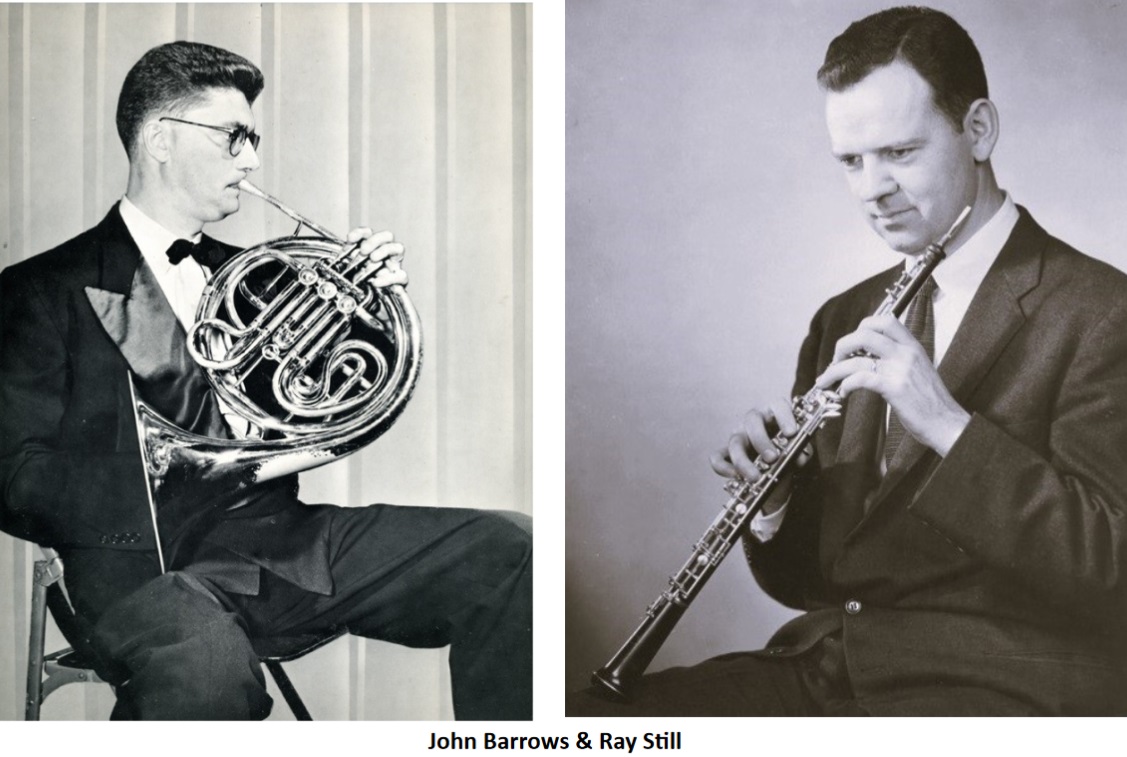


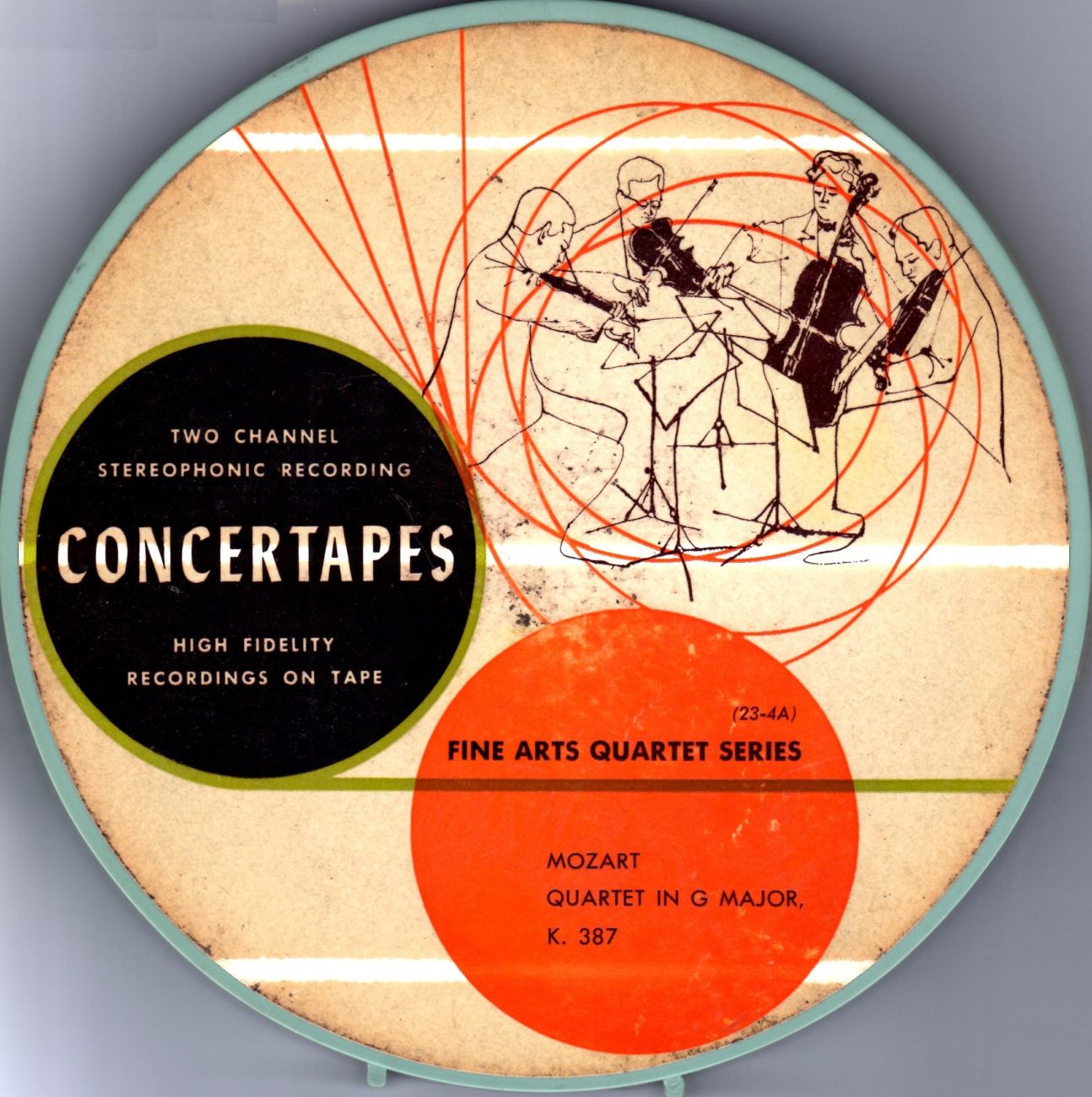

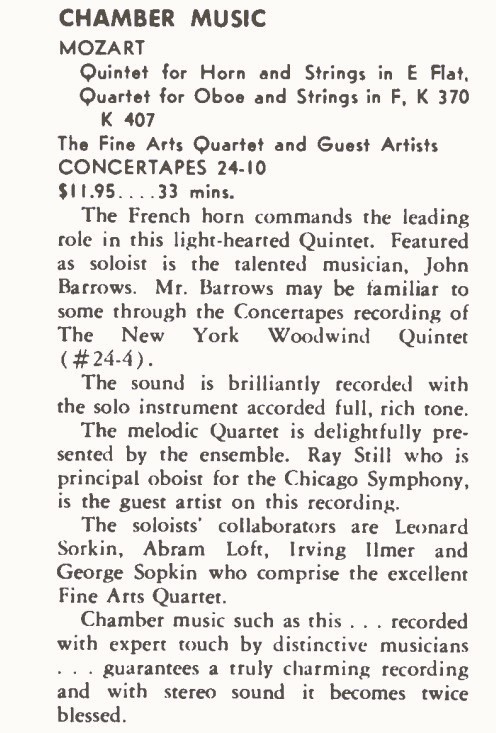
Tape Recording – Janvier/ January 1959

High Fidelity – Juillet/July 1955
The Quintet with Horn K.407 is unusual in that it features only one violin, and two violas. For this recording, Abram Loft plays the first viola, and Irving Ilmer the second.
It is rather difficult to determine the date of the Fine Arts Quartet’s recordings for Webcor/Concertapes. The recording of Quartet K.387, the first in the series dedicated to Joseph Haydn, was first released in mono by Webcor on track A of tape 2923-4, which was reviewed in the July 1955 issue of High Fidelity magazine, and then in stereo in 1956 on the Concertapes label with tape referenced 23-4A. The 1954-1955 date given on the Quartet’s official website is therefore relevant. On the other hand, the date given on the same site (1958) for the other two works (K407 & K370) cannot be held as valid, as the Concertapes 24-10 stereo tape bears 1957 as the publication date.
The Quintet K.407 and the Quartet K.370 are part of the Fine Arts Quartet’s 2016 reissued recordings. The Quartet K.387, on the other hand, has not been reissued since the 1950s, and is therefore a recording rarity.
Horn player John Barrows (1913-1974) was taught by Richard Donovan and David Smith. A member of the Minneapolis Symphony in 1938, he was assistant conductor of the Army Airforce Band during the Second World War, and later played in New York with the City Opera (1946-1949) and the City Ballet (1952-1956). In 1952, he co-founded the New York Woodwind Quintet (with Samuel Baron, flute, Jerome Roth, oboe, David Glazer, clarinet and Bernard Garfield, bassoon), an ensemble that has made several recordings for Concertapes, notably with the Fine Arts Quartet.
Ray Still (1920-2014) began his career in 1939 as second oboist of the Kansas City Philharmonic (1939-1941). After serving in the army until June 1946, he studied with Robert Bloom at the Juilliard School, and from 1947 to 1949 was principal oboe of the Buffalo Philharmonic Orchestra, then conducted by William Steinberg, after which he held the same position for four years with the Baltimore Symphony Orchestra. In 1953, after auditioning for Fritz Reiner, he was hired as second oboe with the Chicago Symphony Orchestra, and promoted to principal oboe the following year. He remained in this position until 1993.
Les liens de téléchargement sont dans le premier commentaire. The download links are in the first comment
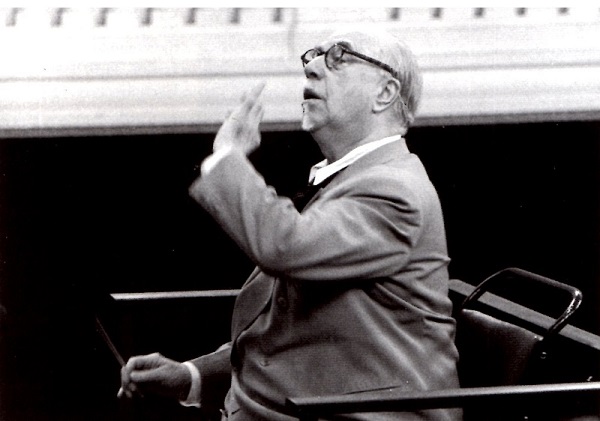
Divertimento n°2 K131 (4 mouvements: I Allegro – II Adagio – III Menuetto II – IV Adagio Allegro molto Allegro assai)
Royal Philharmonic Orchestra (RPO) (Leader Arthur Leavins)
‘Music to Remember 100th’ – BBC Studio Concert – 29 October 1956
______
Symphonie n°29 K201 – BBC Symphony Orchestra (Leader Paul Beard)
Royal Festival Hall (RFH) – 10 October 1956
______
Symphonie n°31 ‘Paris’ K297 – University of Illinois Symphony Orchestra
Mozart Festival University of Illinois – 26 April 1956
Sources: Bandes /Tapes: 19 cm/s /7.5 ips
Trois œuvres de Mozart avec trois orchestres différents, dans trois lieux différents, toutes enregistrées en public au cours de l’année Mozart 1956.
Quelques mois plus tard, fin mars 1957, Beecham a annoncé qu’il s’installait avec son épouse dans le Sud de la France pour des raisons de santé. Il n’allait plus du tout diriger (pour des raisons fiscales) en Angleterre pendant 18 mois, jusqu’à son retour en octobre 1958. Pendant cette période, il a réussi, avec le RPO, à faire des enregistrements à Paris (Salle Wagram) et a monté en octobre 1957 une tournée en Europe. Par la suite, son accord fiscal ne lui permettait pas de rester en Angleterre plus de quatre-vingt-dix jours par an. C’est pourquoi les enregistrements tardifs de Beecham par la BBC sont rares et d’autant plus précieux.
Le Divertimento n°2 K131 (dont il omet les deux mouvements centraux Menuetto I et Allegretto, avec donc le Menuetto II relativement difficile pour le pupitre des cors) débute le programme de la centième édition de ‘Music to Remember‘ avec le RPO, et Beecham ne manque pas de prononcer l’un de ses discours pleins d’esprit. Le programme, qui n’a pas été annoncé à l’avance, est une étrange superposition d’œuvres de six compositeurs différents.
Beecham connaissait Paul Beard depuis 1932 quand il l’avait nommé ‘leader’ (c’est-à-dire ‘Premier Violon’) du London Philharmonic (LPO). Lorsque Beard est devenu en 1936 le ‘leader’ du BBC SO (il le restera jusqu’à sa retraite en 1962), il a rapidement établi une discipline et un contrôle visibles de la section des violons. Lorsque « Tommy » apparut pour la première fois en tant que chef invité du BBC SO, ceci attira son attention et son oreille et, avant la pause de la première répétition, il caressa son menton barbu et, avec un regard narquois et un sourire en direction des cordes, murmura : « Puis-je vous suggérer, messieurs, de prêter un peu plus d’attention à cette barbe (‘beard’) lorsque nous reprendrons ».
L’University of Illinois SO n’était pas un orchestre professionnel, mais l’interprétation donnée lors du Festival Mozart au cours duquel Beecham a dirigé deux programmes ambitieux (24 et 26 avril) est très vivante. Il faut dire que plusieurs semaines de répétitions ont précédé les deux concerts. Le 26 avril, Beecham a également donné une conférence sur Mozart dont le texte a été publié aux pages 174 à 184 du livre de Humphrey Pocter-Gregg ‘Beecham Remembered’ (Duckworth & Co 1976), et dont un extrait concernant la Symphonie ‘Paris’ (n°31 K297) jouée le même jour est donné ci-dessous:
‘La première grande symphonie européenne, complète, d’une maîtrise absolue, d’une structure parfaite, avec le charme de l’invention mélodique, a été écrite par Mozart à Paris. Elle est connue sous le nom de Symphonie de Paris de 1777 – ou de 1778 – j’ai oublié – et je la joue ce soir dans cette institution – la Symphonie de Paris, c’est le premier chef-d’œuvre parmi les symphonies, dont il ne devait pas développer la forme, mais la faire progresser; qu’ Haydn devait accepter et poursuivre, que Beethoven devait accepter et élargir; et que Schubert devait modifier légèrement, mais que tous les compositeurs ultérieurs ont accepté comme base et modèle: tout est contenu dans ceci, le modèle. Comme Tennyson l’a écrit : « Tout le monde peut faire pousser des fleurs maintenant, car tout le monde a la semence ». La graine a été déposée là’.
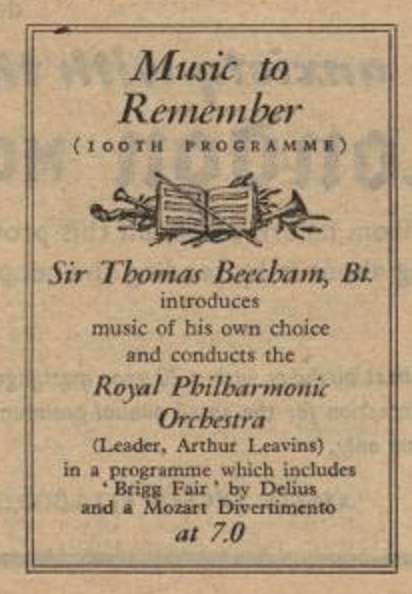

100th ‘Music to Remember’. The Mozart work opens the program

Beecham and the BBC SO at the Royal Festival Hall – October 10, 1956

Beecham – Mozart Festival at the University of Illinois
Three works by Mozart with three different orchestras, in three different venues, all recorded in the Mozart Year 1956.
A few months later, end March 1957, Beecham announced that he and his wife settled in the South of France for health reasons. He was not to conduct at all in England for 18 months (for fiscal reasons) until his return in October 1958. During this period, and with the RPO, he managed to make recordings in Paris (Salle Wagram) and set up in October 1957 a European tour. Thereafter, his tax agreement did not allow him to stay in England for more than ninety days each year. For this reason, late Beecham BBC broadcasts are scarse and all the more treasurable.
The Divertimento n°2 K131 (of which he omits the two middle movements Menuetto I and Allegretto, and thus keeping the Menuetto II with its rather difficult horn parts) begins the 100th programme ‘Music to Remember’ with the RPO, and Beecham does not fail to deliver one of his witty speeches. The programme , not announced in advance, is a strange superimposition of works by six different composers.
Beecham had known Paul Beard since 1932, when he appointed him leader of the London Philharmonic (LPO). When Beard went to lead the BBC SO in 1936 (he retained his post until his retirement in 1962), he soon established a visible discipline and control of the violin section. When ‘Tommy’ first appeared as a guest conductor with the BBC SO, this caught his eye and ear, and before the interval of the first rehearsal, he stroked his barbered chin, and with a sly glance and smile around the strings, murmured: ‘May I suggest to you, gentlemen, that when we reassemble, you pay a little more attention to this beard’.
Although the University of Illinois SO was not a professional orchestra, the performance given at the Mozart Festival during which Beecham conducted two ambitious programs (24 & 26 April) is quite lively. In fact, several weeks of rehearsals preceded the two concerts. On 26 April, Beecham also gave a lecture on Mozart, the text of which was published on pages 174 to 184 of the book by Humphrey Pocter-Gregg ‘Beecham Remembered’ (Duckworth & Co 1976), and of which an excerpt dealing with the ‘Paris’ Symphony (n°31 K297) played the same day is given below:
‘The first great European Symphony, complete, with absolute mastery, with perfection of structure, with charm of melodic invention, was written by Mozart in Paris, known as the Paris Symphony of 1777 – or 1778 – I forget which – and that I am playing tonight in this institution – the Paris Symphony, the first masterpiece among symphonies, the form of which he was not to develop but to carry forward; which Haydn was to accept and carry forward; and which Beethoven was to accept and enlarge; and which Schubert would vary slightly; but which all subsequent composers have accepted as the ground-work and the model: everything is contained in that, the model. As Tennyson wrote: ‘All can raise flowers now, for all have got the seed’. The seed was deposited there.’
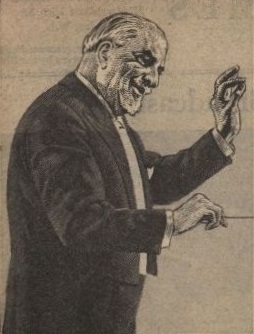
Don’t forget: the name of the programme is ‘Music to Remember‘
Les liens de téléchargement sont dans le premier commentaire. The download links are in the first comment
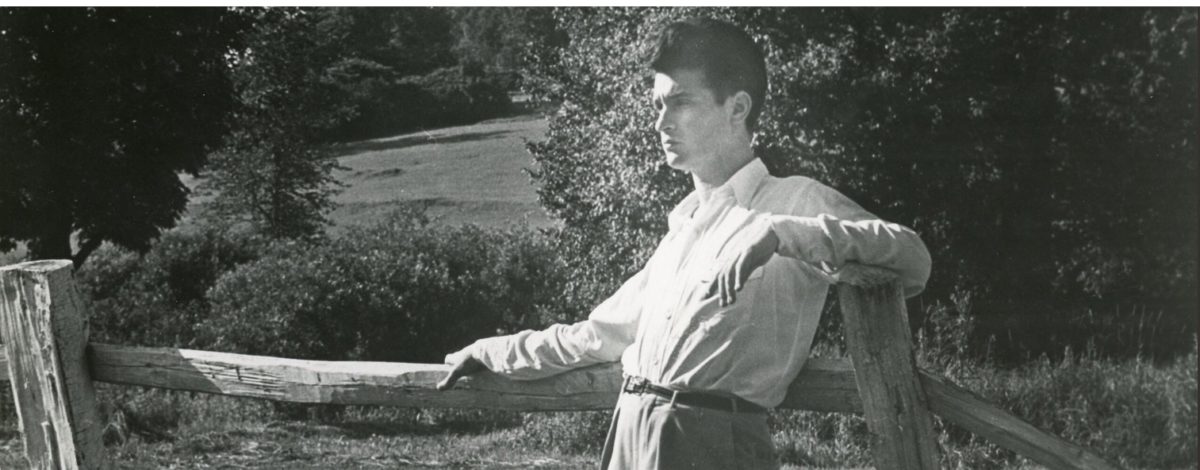
MOZART
Sonate n°10 K330 Carnegie Hall – 21 March 1947
Concerto n°12 K414 II Andante & III Allegretto
San Francisco SO (‘Standard Symphony Orchestra’) Pierre MONTEUX 23 April 1950
William Kapell a laissé relativement peu d’enregistrements mozartiens, mais avec les Sonates K330 et K570, les deux derniers mouvements du Concerto n°12 K414, et enfin les deux précieux enregistrements réalisés à Prades en 1953 (le Concerto n° 17 K 453 sous la direction de Pablo Casals et le Quatuor K493 avec Arthur Grumiaux, Milton Thomas et Paul Tortelier), on peut se faire une idée assez précise de sa conception de la musique de Mozart.
L’enregistrement de la Sonate K330 jouée à Carnegie Hall le 21 mars 1947 a déjà été publié sous le label Marston (3 CD 53021-2), mais les techniques de traitement numérique visant à réduire les bruits de fond et autres défauts, ont laissé des traces. Le document proposé ici reflète la source originale, sans aucun traitement électronique. Non seulement la merveilleuse interprétation de Kapell est reproduite avec une plus grande finesse de détail, mais le son de son piano, et notamment son ampleur est bien mieux rendu.
Des extraits d’une interview (en français) d’ Anna Lou Kapell-Dehavenon, la veuve du pianiste, sont donnés en ‘bonus’. Elle nous parle de deux aspects (romantique et moderne) de la personnalité de Kapell, de ses rencontres avec d’autres musiciens (pianistes et chefs d’orchestre), de son action en tant que professeur et aussi de son trac.
____________
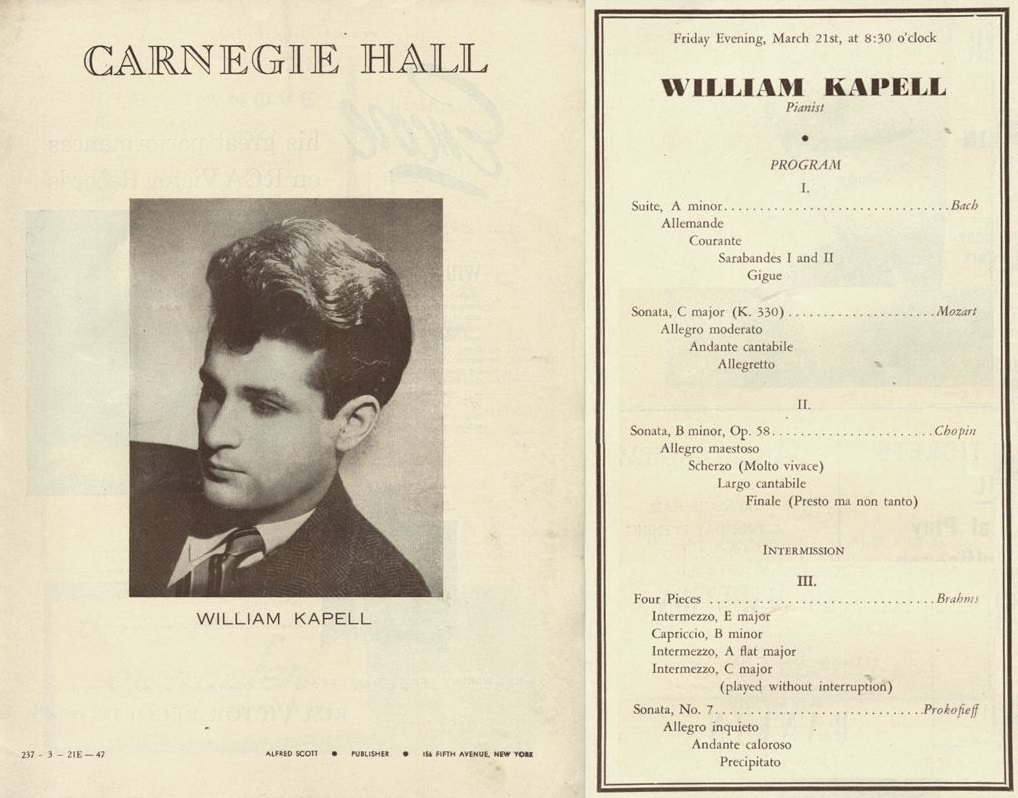 William Kapell Carnegie Hall – 21 March 1947
William Kapell Carnegie Hall – 21 March 1947
____________
William Kapell left relatively few Mozart recordings, but with the Sonatas K330 and K570, the last two movements of Concerto No. 12 K414, and finally the two precious recordings made in Prades in 1953 (Concerto No. 17 K 453 conducted by Pablo Casals and Quartet K493 with Arthur Grumiaux, Milton Thomas and Paul Tortelier), we can imagine a fairly precise idea of his conception of Mozart’s music.
The recording of Sonata K330 given at Carnegie Hall on March 21, 1947 has already been released on the Marston label (3 CD 53021-2), but the processing techniques used to reduce background noise and other defects have left their mark. The document proposed here reflects the original source, without any electronic processing. Not only is Kapell’s wonderful interpretation reproduced with greater finesse of detail, but the sound of his piano, and in particular its fullness, is much better rendered.
Extracts from an interview (in French) of Anna Lou Kapell-Dehavenon, the pianist’s widow, are included as a ‘bonus’. She talks about two aspects (romantic and modern) of Kapell’s personality, his encounters with other musicians (pianists and conductors), his work as a teacher and also his stage fright.
Les liens de téléchargement sont dans le premier commentaire. The download links are in the first comment

Mason Jones Cor / Horn – Philadelphia Orchestra Eugene Ormandy
Enregistrement / Recording:
Concerto n°1 K.412: February 26, 1961
Concerto n°2 K.417:December 3, 1961
Concerto n°3 K.447: February 5, 1961
Concerto n°4 K.495: March 11, 1962
Source: Bande / Tape MQ 796 (4 pistes / 4 tracks; 19 cm/s / 7.5 ips)
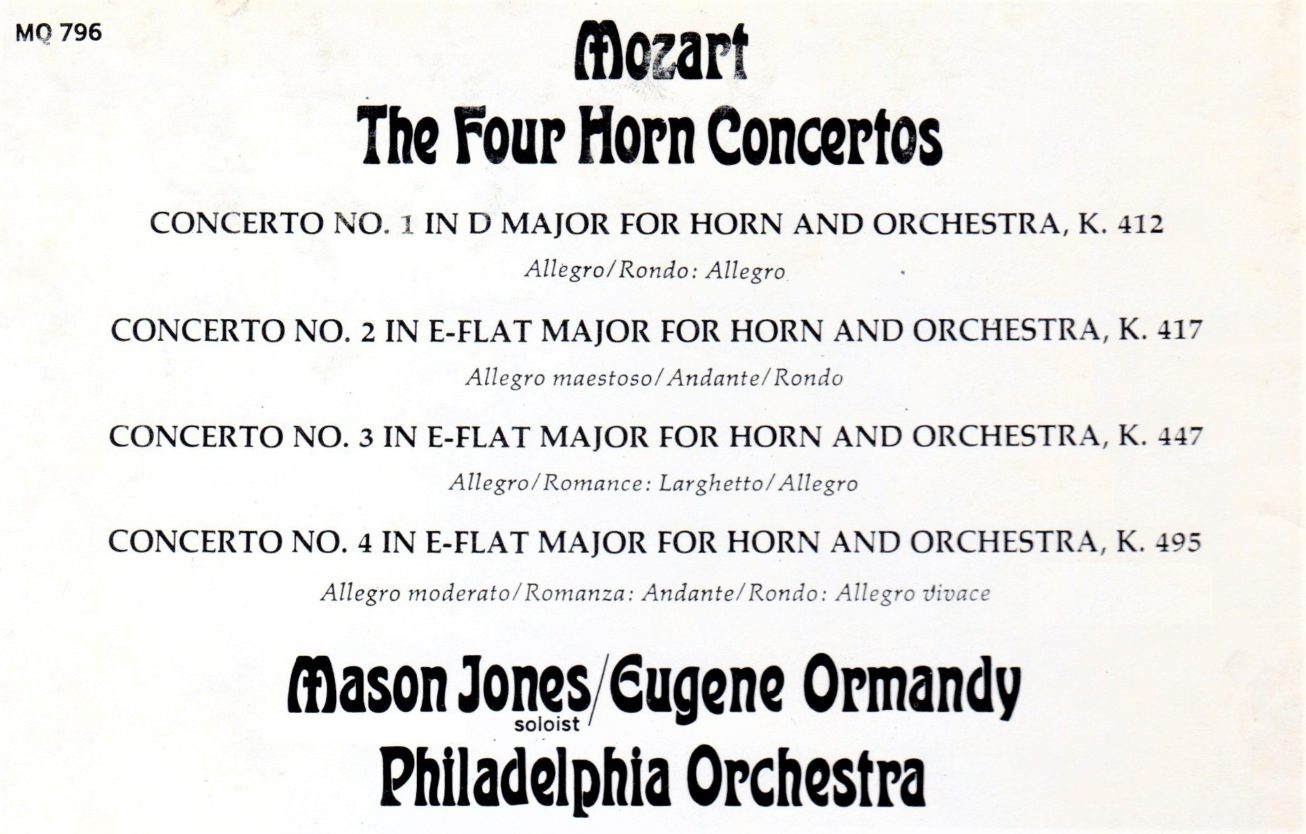
Mason Jones (1919-2009) a rejoint le Philadelphia Orchestra en 1938 en tant que troisième cor, avant d’en devenir le cor solo l’année suivante. Pendant la Deuxième Guerre Mondiale, il a servi comme cor solo de la Marine Band (Washington DC). En 1946, il a retrouvé son poste de cor solo au Philadelphia Orchestra qu’il a conservé jusqu’à sa retraite en 1978. Ces enregistrements des concertos de Mozart mettent en évidence son exceptionnel talent face notamment aux solistes britanniques de l’époque: Dennis Brain, Barry Tuckwell et Alan Civil.
Une particularité: il joue le Rondo du Concerto n°1 K.412 sur un cor naturel (un ‘Waldhorn’ sans pistons).
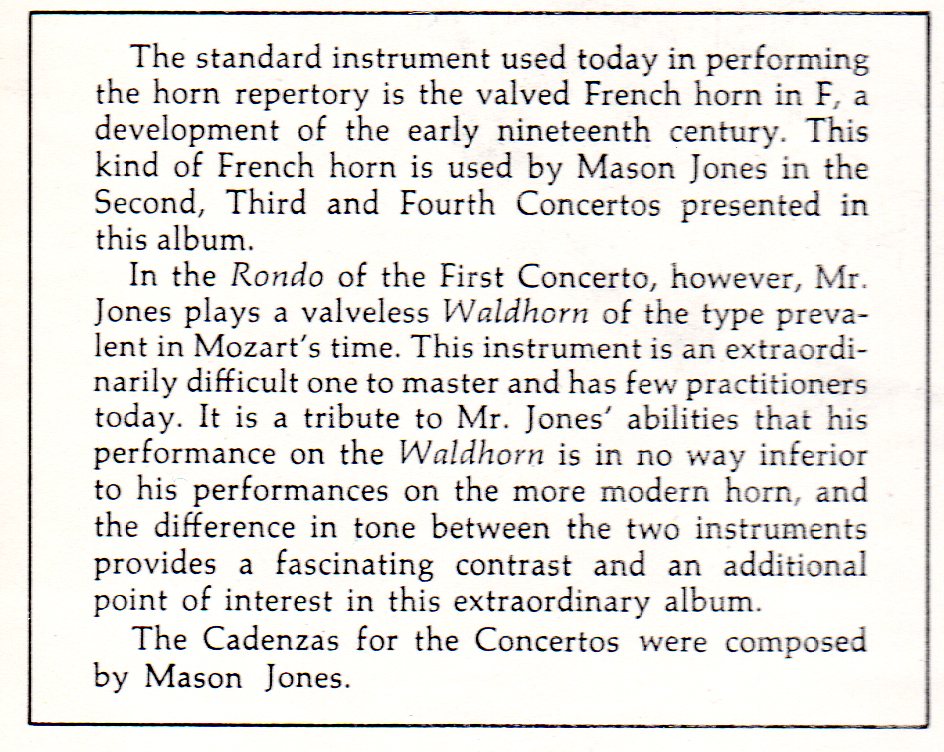
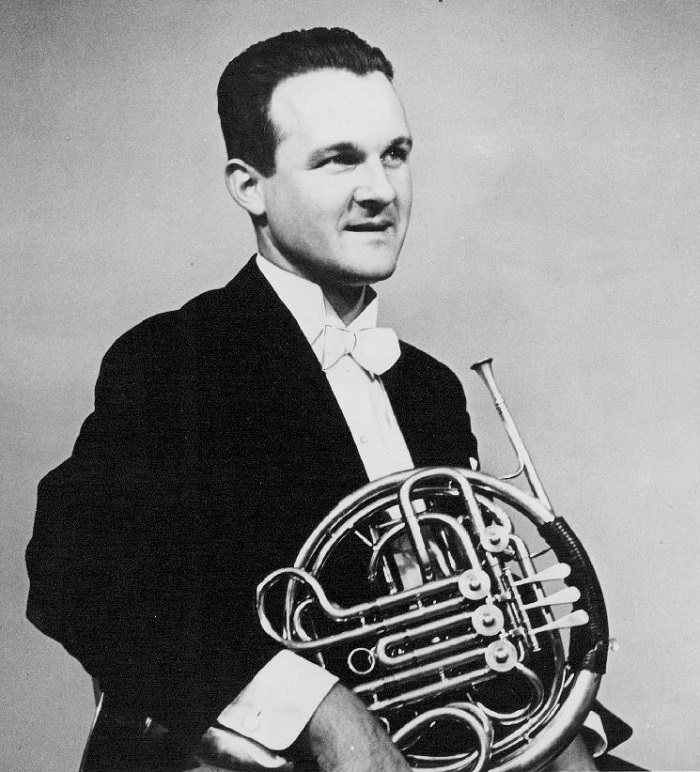
Mason Jones – 1957
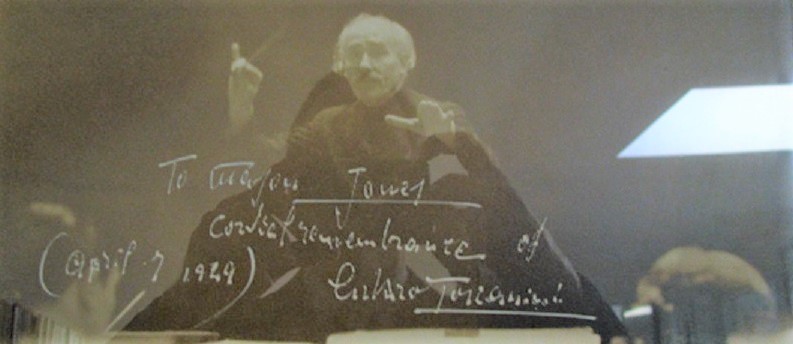
Mason Jones (1919-2009) joined the Philadelphia Orchestra in 1938 as third horn, before becoming principal horn the following year. During World War II, he served as principal horn of the Marine Band (Washington DC). In 1946 he returned to the Philadelphia Orchestra as principal horn, a position he held until his retirement in 1978. These recordings of the Mozart concertos put forward his exceptional talent, especially if we compare him with the British soloists of the time: Dennis Brain, Barry Tuckwell and Alan Civil.
A particularity: he plays the Rondo of the Concerto n°1 K.412 on a natural horn (a valveless ‘Waldhorn’).
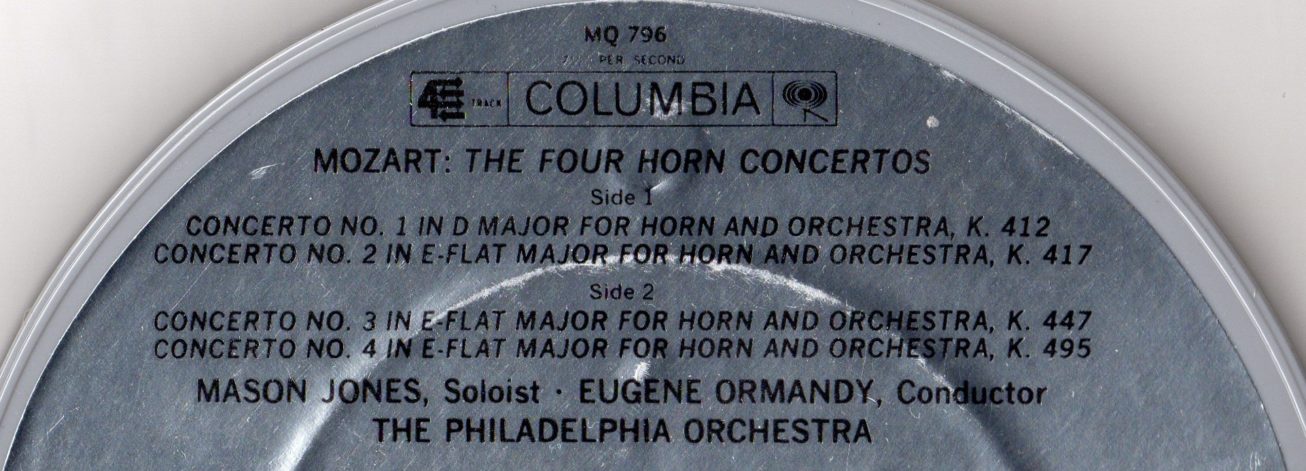

Boskovsky Ensemble – III
HAPPY NEW YEAR 2023 /BONNE ANNEE 2023


Œuvres de Lanner, Mozart, Schubert, et de J. Strauss Sr. et Jr.
Boskovsky Ensemble (chefs de pupitre du WPO)
Violon I : Willi Boskovsky (1908-1991) « Stimmführer » des violons I de 1934 à 1938, puis Konzertmeister de 1938 à 1970
Violin II : Wilhelm Hübner (1914-1996) « Stimmführer » des violons II de 1954 à 1964, « Vorgeiger » ensuite jusqu’en 1980 (retraite)
Violin III et Alto: Rudolf Streng (1915-1988) violon I de 1938 à 1959; alto solo de 1959 à 1980 (retraite)
Contrebasse: Otto Rühm (1906-1979) contrebasse solo de 1955 à 1971 (retraite)
Flûte – Josef Niedermayr (1900-1962) flûte solo de 1933 à 1962
Clarinette – Rudolf Jettel (1903-1981) clarinette solo de 1945 à 1968 (retraite)
Cors: Otto Nitsch (1906-1982) 2ème cor de 1941 à 1971; Roland Berger(1937) 3ème cor au Wiener Staatsoper (1955); cor solo de 1961 à 1984; de nouveau 3ème cor de 1984 à 1993 (retraite)
L’enregistrement a été réalisé en 1960 dans la Festsaal du Casino de Baumgarten.
Source: Bande / Tape VTC-1634 – 4 pistes / 19 cm/s – 4 tracks 7.5 ips
Les œuvres sont les suivantes:
01- Johann Strauss Sr. : Chinesischer Galopp 2 violons, alto, contrebasse, flûte, clarinette, 2 cors
02- Johann Strauss Sr. : Kettenbrücke Walzer 2 violons, contrebasse
03- Johann Strauss Sr. : Eisele und Beisele Sprünge 2 violons, alto, contrebasse, flûte, clarinette, 2 cors
04- Josef Lanner: Styrian Dances 2 violons, alto, contrebasse
05- Wolfgang Amadeus Mozart: 3 Contredanses K.462-1 6&5-24-88 – 2 violons, alto, flûte, clarinette, 2 cors
06- Johann Strauss Jr: Wiener Gemüths 2 violons, alto, contrebasse
07-Wolfgang Amadeus Mozart: 4 Deutsche Tänze K.600 n°3, K.605 n°1, K.686 n°11, K.600 n°1 – 2 violons, alto, flûte, clarinette, 2 cors
08-Franz Schubert: 8 Wälzer und Ländler Op.9 n°2, Op.18 n°1,3, Op.9 n°14,35, Op.33 n°10, Op.127 n°15,18
09-Johann Strauss Jr: Champagne Galopp
10-Josef Lanner: Die Werber Walzer 3 violons, contrebasse
11-Johann Strauss Sr: Cachucha Galopp
Parmi les œuvres de Johann Strauss Sr (1804- 1849), on trouve un de ses premiers grands succès, la ‘Kettenbrücke Walzer’, composée en 1828 pour célébrer le premier pont suspendu (à chaînes) de Vienne, construit à proximité du palais Rasoumovsky et inauguré en 1825, un sujet inattendu pour une valse!
L’ère de la Famille Strauss s’est ainsi ouverte immédiatement après Haydn, Mozart, Beethoven et Schubert qui ont également composé de la musique populaire.
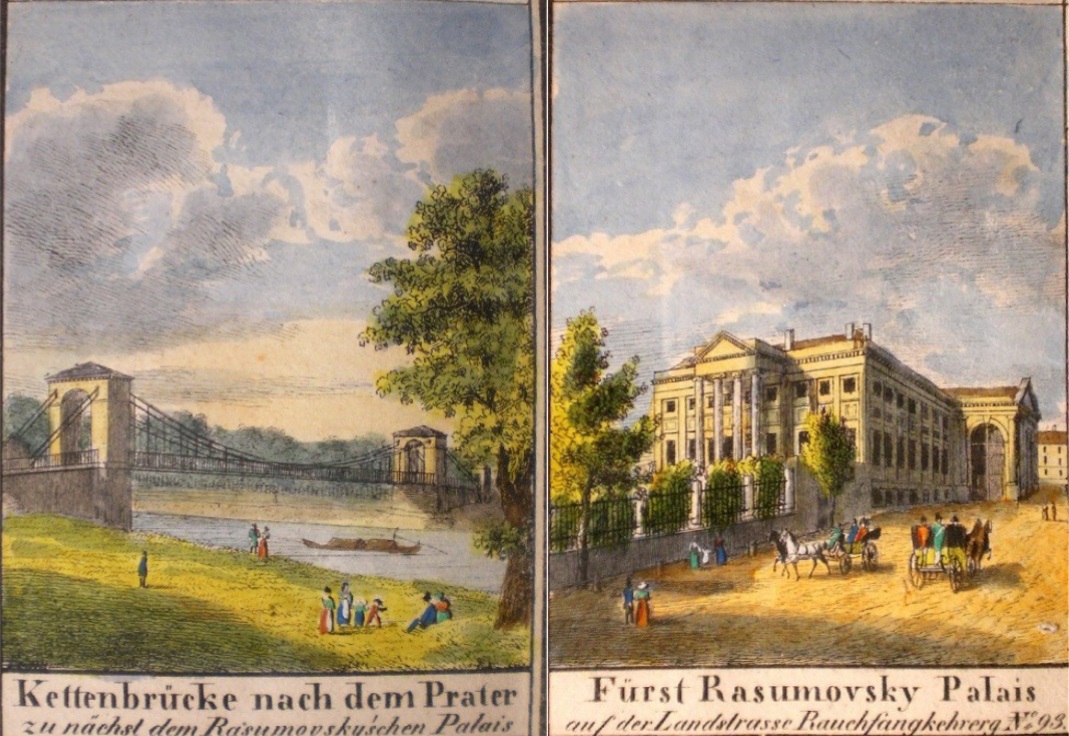
Kettenbrücke beim Palais Rasumovsky nach dem Prater

Works by Lanner, Mozart, Schubert, and by J. Strauss Sr. and Jr.
Boskovsky Ensemble (first desk men of the WPO):
Violin I : Willi Boskovsky (1908-1991) « Stimmführer » of violins I from 1934 to 1938, then Konzertmeister from 1938 to 1970
Violin II : Wilhelm Hübner (1914-1996) « Stimmführer » of violins II from 1954 to 1964, then « Vorgeiger » until 1980 (retirement)
Violin III and Viola: Rudolf Streng (1915-1988) violin I from 1938 to 1959; solo viola from 1959 to 1980 (retirement)
Double-bass: Otto Rühm (1906-1979) solo double-bass from 1955 to 1971 (retirement)
Flute: Josef Niedermayr (1900-1962) in the orchestra since 1921; solo flute from 1933 to 1962
Clarinet: Rudolf Jettel (1903-1981) solo clarinet from 1945 to 1968 (retirement)
Horns: Otto Nitsch (1906-1982) 2nd horn from 1941 to 1971; Roland Berger(1937) 3rd horn at the Wiener Staatsoper (1955); solo horn between 1961 and 1984; then again 3rd horn between 1984 and 1993 (retirement)
The recording was made in 1960 in the Festsaal of the Baumgarten Casino.
Source: Tape VTC-1634
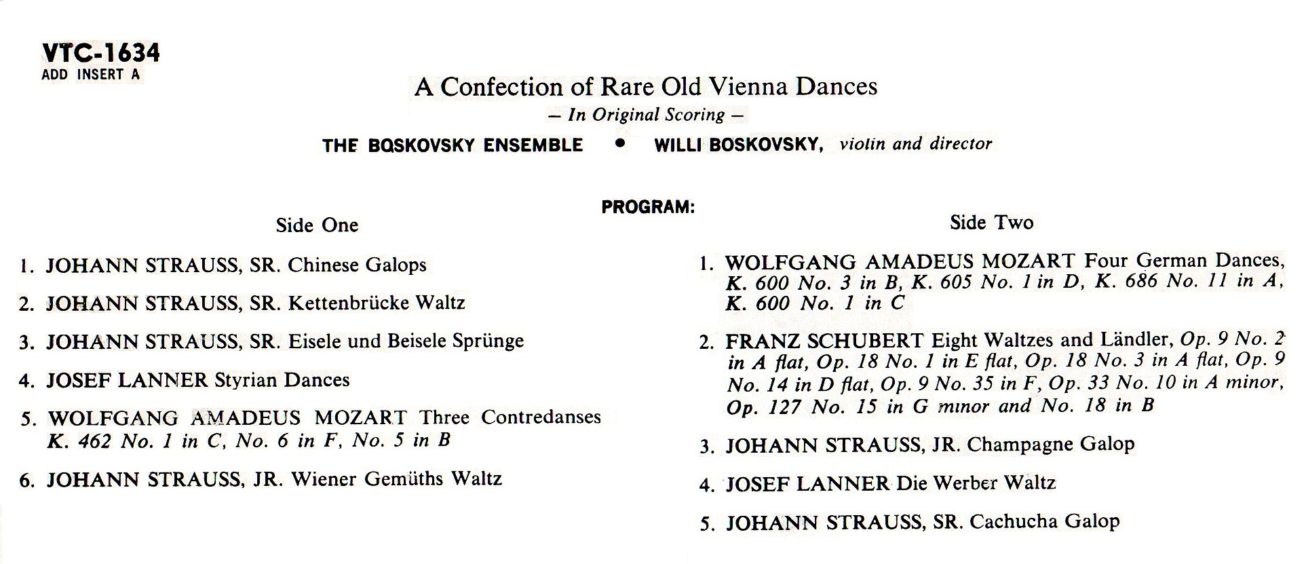
Among the works by Johann Strauss Sr (1804- 1849), we find one of his first great ‘hits’, the ‘Kettenbrücke Walzer’, composed in 1828 to celebrate the first chain suspension bridge in Vienna, built near the ‘Rasumovsky Palais’ and inaugurated in 1825, a rather unexpected subject for a waltz!
Then, the Strauss Family era took over shortly after Haydn, Mozart, Beethoven and Schubert who also composed popular music.

Les liens de téléchargement sont dans le premier commentaire. The download links are in the first comment.



